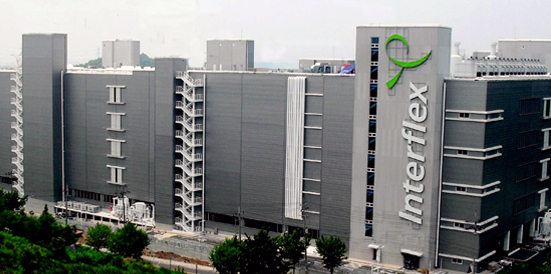Interflex, a leading provider of flexible printed circuit boards, was hoping to see a turnaround from long-running deficits to a surplus by the third quarter of this year -- until it was hit by Samsung Electronics’ Galaxy Note 7 debacle.
In August, the exclusive supplier of digitizers -- cutting-edge circuit boards that enable the function of the Galaxy S pen used in the smartphone -- had seen its stock value hit the peak of 21,200 won ($18) amid an upbeat mood for the new phablet. The mood had continued until early October.
 |
Interflex’s headquarters in Ansan, Gyeonggi Province (Interflex) |
But the stock rallies suddenly stopped as Samsung announced on Oct. 10 a permanent halt in production of the Note 7 model that had overheating and explosion problems.
Due to the halt, Interflex had to put aside its expectations for a turnaround this year and prepare measures for next year.
“We have given up on the fourth quarter, to instead prepare for next year,” said a manager in charge of investor relations at the company.
“We are planning to ramp up Apple’s share in sales as much as possible next year.”
The investor relations manager said the company is expecting a meaningful improvement in earnings to materialize in the second quarter of 2017.
Interflex has been providing flexible printed circuit boards for the organic light-emitting diode display panels of iPhones, which account for about 15 percent of its total sales. Next year, the company plans to increase this proportion up to 60 percent as it aims to provide boards for the iPhone 8.
According to market analysts, the company is capable of supplying the boards for as many as 10 million units of iPhones per month and 80 million per year, considering its current production capacity.
“As the company starts running its plant in Vietnam, it will gain a competitive edge in unit costs, and increasing supplies for its overseas clients next year will help the firm perform better,” said Kim Uno, an analyst at IBK Investment & Securities. Kim raised the company’s stock target price to 30,000 won.
After hitting 15,300 won on Sept. 26 in the wake of a series of explosions of the Galaxy Note 7, the share value gradually rebounded to the 16,000 won level. It finished at 16,400 won on Monday, 4.79 percent higher than the previous trading session.
According to regulatory filings, Interflex has narrowed its operating losses from 92 billion won in 2014 to 85 billion won in 2015. Market estimates show the losses will be significantly reduced to 11 billion won this year, while a 69 billion won surplus is being forecast for next year.
The company announced a plan to raise 58 billion won in capital in a regulatory filing in late October, which will be used to expand its Vietnam factory and repay loans.
Founded in 1994, Interflex has been leading development of the flexible printed circuit boards
for mobile phones, ranging from folder-types in the early stage to the latest smartphones.
To meet rising demand abroad, the company established plants in Hanoi, Vietnam, in 2015 and Tianjin, China in 2009.
Since going public on the Kosdaq in January 2003, the firm surpassed 1 trillion won in market capitalization for the first time in August 2012.
By Song Su-hyun (
song@heraldcorp.com)








